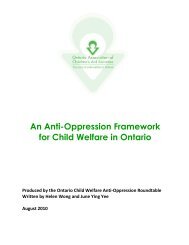English - Ontario Association of Children's Aid Societies
English - Ontario Association of Children's Aid Societies
English - Ontario Association of Children's Aid Societies
You also want an ePaper? Increase the reach of your titles
YUMPU automatically turns print PDFs into web optimized ePapers that Google loves.
violence which is linked to the violence that is directed to Aboriginal peoples in<br />
individual and systemic ways.<br />
VIOLENCE AGAINST ABORIGINAL WOMEN<br />
Indigenous girls and young women comprise the most marginalized, exploited<br />
and frequently victimized population group in Canada. The roots <strong>of</strong> this tragedy<br />
are found in the ongoing effects <strong>of</strong> colonial oppression evidenced by myriad and<br />
extreme social and economic inequalities (NWAC, 2010; Ruttan et al, 2010; Amnesty<br />
International, 2009; Novac et al, 2002; RCAP, 1996; Status <strong>of</strong> Women Canada, 1993).<br />
Although it has long been recognized that Indigenous girls and women experience<br />
disproportionately higher and far more brutal forms <strong>of</strong> harassment, sexual<br />
exploitation, violence and murder there is still no coherent, integrated strategy<br />
to protect, support and strengthen them (Chansonneuve, 2010).<br />
Although Indigenous women represent three percent <strong>of</strong> the Canadian population,<br />
they are over-represented as victims <strong>of</strong> racialized, sexual violence. Fifty-four percent<br />
<strong>of</strong> Aboriginal women experience severe and potentially life threatening forms <strong>of</strong><br />
violence. These conditions are unacceptable.<br />
The Native Women’s <strong>Association</strong> <strong>of</strong> Canada (NWAC) initiative entitled Sisters in Spirit<br />
brought to the world’s attention that the level <strong>of</strong> violence against Aboriginal women<br />
was so extreme that it had resulted in 500 missing and murdered women. Upon<br />
completion <strong>of</strong> five years <strong>of</strong> research, the NWAC had a database <strong>of</strong> information about<br />
more than 630 missing and murdered Aboriginal women.<br />
In 2008, the National Clearinghouse on Family Violence released the following<br />
statistics:<br />
> > 343 Aboriginal females out <strong>of</strong> every 1,000 are victims <strong>of</strong> violent crimes,<br />
compared to 96 out <strong>of</strong> every 1,000 non-Aboriginal women<br />
> > Aboriginal females are 3.5 times more at-risk to be a victim <strong>of</strong> a violent crime<br />
than non-Aboriginal women<br />
> > Aboriginal women are eight times more likely to suffer abuse than<br />
non-Aboriginal women; and <strong>of</strong> those women, 87 percent had been<br />
physically injured and 57 percent had been sexually abused<br />
The Métis do not have gender specific statistics, yet the rates <strong>of</strong> violence reported<br />
indicate a prevalence <strong>of</strong> violence, sexual abuse and sexual assault. The few statistics<br />
available indicate that 39 percent <strong>of</strong> Métis experienced family violence, 23 percent<br />
experienced sexual abuse and 14.6 percent experienced rape.<br />
29

















